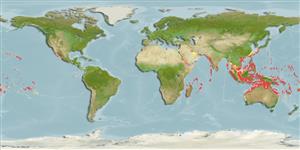Environment: milieu / climate zone / depth range / distribution range
Ökologie
seewasser riff-verbunden; tiefenbereich 1 - 65 m (Ref. 90102). Tropical; 32°N - 32°S
Indo-Pacific: Mauritius and the Cargados Carajos Shoals and Sri Lanka to French Polynesia (Moorea and Scilly Atoll); north to Japan; south to Australia.
Size / Gewicht / Alter
Maturity: Lm ? range ? - ? cm
Max length : 8.6 cm SL Männchen/unbestimmt; (Ref. 1602)
Rückenflossenstacheln (insgesamt): 7 - 8; Rückenflossenweichstrahlen (insgesamt): 19-22; Afterflossenstacheln 3; Afterflossenweichstrahlen: 15 - 18; Wirbelzahl: 25 - 27. Brownish with dusky reticulations (Ref. 6635). No dermal flap or small tentacle dorsally on eye. Two large pores in interorbital space, one on each side close to the edge of the orbit. Tubular anterior nostril near the edge of the snout at the base of the upper lip, the tube is not long; when laid back reaching almost half way to posterior nostril. Second lateral line not fully developed. Longitudinal scale series 46-50(Ref. 27020).
Secretive (Ref. 48635); lives among corals of shallow reef flats and lagoons (Ref. 1602). Also found under dead coral pieces but quickly sneaks away when looking underneath (Ref. 48635). Solitary (Ref 90102).
Life cycle and mating behavior
Geschlechtsreife | Fortpflanzung | Ablaichen | Eier | Fecundity | Larven
Randall, J.E. and C.C. Baldwin, 1997. Revision of the serranid fishes of the subtribe Pseudogrammina, with descriptions of five new species. Indo-Pac. Fish. (26):56 p. (Ref. 27020)
IUCN Rote Liste Status (Ref. 130435)
Warning: mysqli::__construct(): (HY000/1040): Too many connections in /var/www/html/includes/func_getlabel.php on line 46
Can't connect to MySQL database (fbapp). Errorcode: Too many connections
